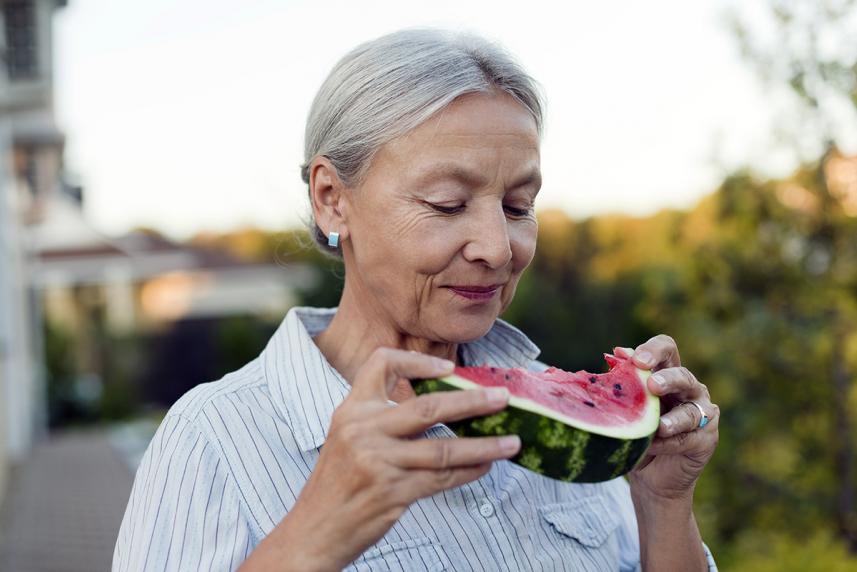
We have more than 90,000 doctors at over 2,000 locations. Our team will help you get the care you need, when and where you need it.

Now is the perfect time to add some new fruits and veggies to your meals. Bonus: You’ll help your health, too.
If you’ve been to the grocery store lately, you can’t miss all the color in the produce section. And with so many juicy fruits and veggies to choose from, this is the easiest time of year to eat better.
“Eating seasonally doesn’t just give you health benefits. It can also be more affordable,” says Lauren Spradling, RD, a wellness coach for Real Appeal with Rally.
The more colorful the produce, the more likely it is to have vitamins and minerals that fight disease. Those vivid hues come from different compounds produced by plants called phytonutrients. These have been shown to have significant health benefits.1
“Plus, fresh produce is high in water and fiber content. That can help keep you on track with your wellness goals during the summer,” Spradling adds. “Try to eat the rainbow: Whether fresh, frozen or canned, fruit and veggies of all colors have great health benefits.” If you’re buying canned or frozen veggies, choose low-sodium types. For canned fruit, make sure there’s no added sugar.
Read on for Spradling’s top summer produce picks and the health benefits you can get from each. (For more tips you can trust, sign up for our newsletter today.)
They’re tiny but mighty. Strawberries, blueberries, blackberries and raspberries are packed with fiber. Berries also have plenty of vitamin C and a ton of antioxidants. Those are substances that protect your cells from damage. They can also help fight heart disease and cancer, according to a study in Current Opinion in Food Science. They can also help manage blood sugar, lower cholesterol and improve digestion.2 And they taste great, too.
Enjoy them: Naturally sweet, fresh summer berries are a delicious treat on their own. Or add them to yogurt, oatmeal or smoothies for breakfast.
Peppers are among the most versatile summer vegetables. They range from sweet to hot and come in every color of the rainbow. Each type of pepper has a different set of phytonutrients depending on its color, says Spradling. Phytonutrients are plant chemicals that help prevent disease. They may also help protect against heart disease and cancer.3 Spradling suggests trying a variety of peppers throughout the summer.
Enjoy them: Add bell peppers to a raw veggie tray alongside low-fat dip or toss them on the grill for fajitas. Hot peppers can add spice to salsas and sauces.
Lettuces, which vary from pale white to deep green, are packed with nutrition. Heartier greens such as kale and collards pack a lot of vitamin K. This helps the body form scabs and heal from injury.4 Even watery iceberg lettuce has its place. It’s filling, hydrating and refreshing.
Enjoy them: “Like peppers, you can vary your greens throughout the summer,” Spradling says. She suggests trying collard greens, Swiss chard, kale, spinach and all the varieties of lettuce. “Some greens are better cooked and others raw. You can really experiment with a lot of recipes,” she says.
These mildly sweet and floral gems are a special treat in late summer. And they’re a treat for your health, too. Figs are a good source of calcium, potassium and magnesium. These minerals work together to maintain bone density. They’re also natural laxatives, says Spradling. They contain prebiotics that promote good gut health. Prebiotics help feed the healthy bacteria that live in your body.5
Enjoy them: Spradling suggests adding figs to a summertime party tray. They’re as pretty as they are delicious.
Nothing says summer quite like a fresh watermelon wedge. As the name suggests, this juicy melon is more than 90% water, making it a great hydrating food choice on a hot summer day. That also makes it low in calories and surprisingly filling. In fact, a recent study found that watermelon was more filling than low-fat cookies with the same number of calories. Participants who ate 2 cups’ worth of watermelon each day felt less hungry and lost weight.6
Enjoy it: Eat it on its own or as part of a fruit salad. You can also blend it into a refreshing drink with a splash of lime juice. Just toss it in the blender until it's smooth.

We have more than 90,000 doctors at over 2,000 locations. Our team will help you get the care you need, when and where you need it.
Related to melons, cucumbers are also made mostly of water. This means they’re low in calories but high in micronutrients.
Enjoy them: They can add crunch to everything from sandwiches and salads to dips. Add them to water for a refreshing and flavorful twist. Cucumbers are also great for your skin, thanks to their high levels of vitamin K and other nutrients, according to research published in The Journal of Aging Research & Clinical Practice. They can even soothe a sunburn. Just place slices of chilled cucumber on sunburned skin for instant relief.7
There is always an abundance of zucchini in late summer. Plus, its high in many vitamins and minerals, including vitamin C.8
Enjoy it: Spradling’s favorite way to use this veggie is to make zucchini bread. When mixed with whole-grain flours and nutrient-dense add-ins such as walnuts, this quick bread provides loads of fiber and nutrients. It’s great for an easy breakfast on the go. Or it’s the perfect sweet ending to an outdoor summer meal. Make a double batch and freeze one loaf for later.

Recipes for green beans may vary based on what part of the country you’re from. Spradling grew up eating pickled green beans, for instance. “Fermented foods have important health benefits,” she says. “They’re great for gut health.” That’s because they’re full of good bacteria that support a healthy gut microbiome, which can aid digestion, boost mood and strengthen your immune system.9 Green beans are also a wonderful source of plant-based fiber and protein.
Enjoy them: They’re usually eaten cooked, but green beans are also great raw. Dip tender ones into Greek yogurt for a healthy snack.
Tomatoes are filled with an antioxidant called lycopene. It may help manage metabolic syndrome and prevent certain cancers, particularly prostate cancer.10 Cooking tomatoes increases the amount of lycopene they contain. But they’re good raw, too. They contain nearly 20% of the recommended daily amount of vitamin C per tomato.11
Enjoy them: Peak summer tomatoes can’t be beat for flavor. Add juicy slices to salads and sandwiches. Or try a caprese salad: Layer slices of tomato along with fresh mozzarella, then top it with fresh basil and a drizzle of balsamic vinegar and olive oil. Grilling pizza? Use them to make your own sauce.
Possibly the ultimate summer treat, peaches are so delicious that they can be a dessert on their own. Peaches are packed with immune-boosting antioxidants and fiber that promote good gut health and help stabilize blood sugars.12
Enjoy them: They’re tasty right off the tree, but if you want to jazz things up, try tossing them on the grill and serving them with creamy yogurt and crunchy pecans. Or, if peach cobbler or pie is what you’re craving, Spradling suggests making a baked crumble. Top it with a mix of oats, nuts and seeds, instead of making a traditional pie crust.
Of course, no single food can prevent disease, says Spradling. “You have to eat a variety of foods to get the full spectrum of benefits.” With all the variety of summer produce out there right now, it’s a great time of year to diversify your cooking routine. “Mix up the colors of your summertime produce to celebrate good health,” Spradling says.
Find more simple tips for healthy eating on our Until It’s Fixed podcast
Stock up on all your health essentials, including vitamins, cold medicine, first-aid supplies and more, at the Optum Store. Don’t forget to use your HSA/FSA funds to save. Shop now.
Sources
© 2024 Optum, Inc. All rights reserved. Do not reproduce, transmit or modify any information or content on this website in any form or by any means without the express written permission of Optum.
The information featured in this site is general in nature. The site provides health information designed to complement your personal health management. It does not provide medical advice or health services and is not meant to replace professional advice or imply coverage of specific clinical services or products. The inclusion of links to other websites does not imply any endorsement of the material on such websites.
Consult your doctor prior to beginning an exercise program or making changes to your lifestyle or health care routine.
Stock photo. Posed by model.